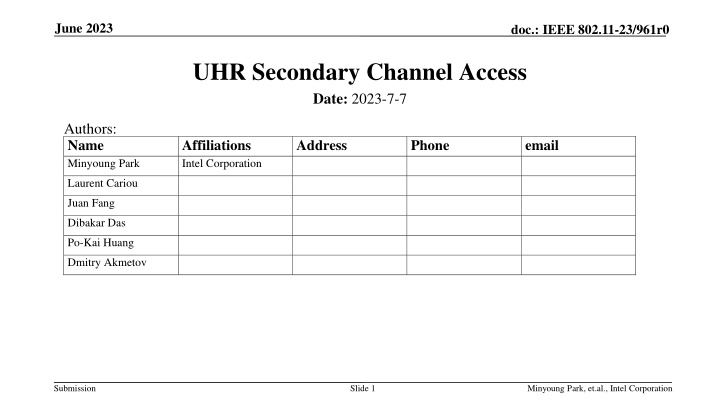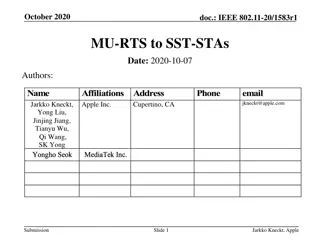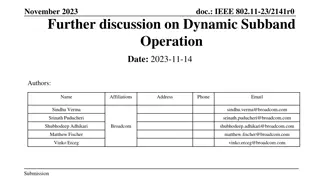Proposal for Improved Channel Access Efficiency in IEEE 802.11 Networks
The proposal addresses the inefficiencies in utilizing secondary channels in IEEE 802.11 networks, aiming to enhance access to wideband channels (>20 MHz) when the primary channel is busy. It introduces a mechanism for APs and STAs to access available secondary channels while the primary channel is occupied, optimizing spectrum utilization. The design considerations emphasize simplicity and minimal additional receiver capability on secondary channels for seamless operation. The proposed AP behavior involves monitoring idle/busy status on a second primary channel, initiating transmission with specified control frames based on channel conditions. STA behavior includes transitioning to the secondary channel upon detecting primary channel busyness and awaiting control frames from the AP.
Download Presentation

Please find below an Image/Link to download the presentation.
The content on the website is provided AS IS for your information and personal use only. It may not be sold, licensed, or shared on other websites without obtaining consent from the author.If you encounter any issues during the download, it is possible that the publisher has removed the file from their server.
You are allowed to download the files provided on this website for personal or commercial use, subject to the condition that they are used lawfully. All files are the property of their respective owners.
The content on the website is provided AS IS for your information and personal use only. It may not be sold, licensed, or shared on other websites without obtaining consent from the author.
E N D
Presentation Transcript
June 2023 doc.: IEEE 802.11-23/961r0 UHR Secondary Channel Access Date: 2023-7-7 Authors: Name Minyoung Park Affiliations Intel Corporation Address Phone email Laurent Cariou Juan Fang Dibakar Das Po-Kai Huang Dmitry Akmetov Submission Slide 1 Minyoung Park, et.al., Intel Corporation
June 2023 doc.: IEEE 802.11-23/961r0 Problem For any 802.11 transmission (20/40/80/160/320MHz), The primary 20 MHz channel must be idle to access a wideband channel (>20 MHz) A STA cannot transmit on any idle secondary channels if the primary channel is busy This is not the best way to utilize < 7 GHz bands, especially for 160/320 MHz frequency Busy (STA to AP or AP to STA) Secondary channels available Secondary 40MHz Busy 80MHz PPDU Busy Available Secondary 20MHz 40MHz PPDU (interference, OBSS) 20MHz PPDU (interference, OBSS) Primary 20MHz time Now STA can transmit a packet Submission Slide 2 Minyoung Park, et.al., Intel Corporation
June 2023 doc.: IEEE 802.11-23/961r0 Goal If the primary channel is busy and the secondary channel(s) are available, an AP/STA transmits on the available secondary channel(s) frequency Busy (STA to AP or AP to STA) Secondary 40MHz 40MHz PPDU Busy 60MHz PPDU 80MHz PPDU Busy Secondary 20MHz 40MHz PPDU (interference, OBSS) 20MHz PPDU (interference, OBSS) Primary 20MHz time STA can transmit a packet on the secondary channels while the primary channel is busy Submission Slide 3 Minyoung Park, et.al., Intel Corporation
June 2023 doc.: IEEE 802.11-23/961r0 Design considerations Need to be simple Before using the secondary channels, an AP/STA needs to know idle/busy status of the secondary channels No major additional receive capability on the secondary channels Submission Slide 4 Minyoung Park, et.al., Intel Corporation
June 2023 doc.: IEEE 802.11-23/961r0 Proposal AP behavior (transmitter) Monitors medium idle/busy on the second primary channel (P2) ED/PD CCA: e.g.,STF detection If the first primary channel (P1) is busy for NAV time duration and the second primary channel is idle for X (TBD) time duration On the second primary channel, AP does backoff and initiates TXOP with BSRP Trigger or RTS frame (a control frame) to target STA(s) RTS/CTS or BSRP/BSR type of control frame exchange is needed to know if the target STAs are on the second primary channel The TXOP ends before the NAV=0 set at the first primary channel STA behavior (receiver) If the first primary channel is busy for NAV time duration Move to the second primary channel and wait for BSRP or RTS (a control frame) from the AP STA goes back to the first primary channel before NAV=0 of the first primary channel ED/PD CCA Access secondary channels if medium Idle for > X time duration (a value >PIFS and < maxPPDU) Frame exchanges end before NAV =0 on P1 (to keep the medium sync on P1) frequency (idle) Busy S1.3 20MHz S2.1 20MHz PIFS PIFS OBSS frame exchanges (busy) BSRP BSR BA 40MHz PPDU (TX) P2 20MHz 2nd primary Busy S1.2 20MHz BSRP BO BSR BA 80MHz PPDU (TX) S2.2 20MHz S1.1 20MHz 40MHz PPDU (TX) BSRP OBSS frame exchanges (busy) (both AP and STA received OBSS packet and set NAV) BSR BA S2.3 20MHz P1 20MHz 1st primary Busy NAV=0 AP/STA decode OBSS packet or PHY preamble and sets NAV Submission Slide 5 Minyoung Park, et.al., Intel Corporation
June 2023 doc.: IEEE 802.11-23/961r0 When AP and STA have different views on channel idle/busy From AP side P1 is busy (NAV set) but from STA side P1 is idle AP may send BSRP or RTS on P2 and available secondary channels STA is not monitoring P2 and does not respond to BSRP/RTS STA may send RTS on P1 AP is monitoring P2 and does not respond to RTS on P1 From AP side P1 is idle but from STA side P1 is busy (NAV set) AP may send BSRP or RTS on P1 and available secondary channels (not including P2) STA is waiting on P2 and does not respond to BSRP/RTS on P1 AP may send BSRP or RTS on P1 and available secondary channels (including P2) STA is waiting on P2 and may respond to BSRP/RTS on P2 STA may send RTS on P2 AP is monitoring P1 and does not respond to RTS on P2 For simplicity, frames on P2 while P1 is idle is ignored to avoid decoding OBSS frames on secondary channels (while decoding OBSS frames on secondary channels create blindness on the primary) Decode frames on P2 only when P1 is busy Slide 6 Submission Minyoung Park, et.al., Intel Corporation
June 2023 doc.: IEEE 802.11-23/961r0 Summary The current secondary channel access mechanism is inefficient for a wideband channel (e.g., 160 or 320 MHz) UHR needs a better secondary channel access scheme to fully utilize a wideband channel Submission Slide 7 Minyoung Park, et.al., Intel Corporation























